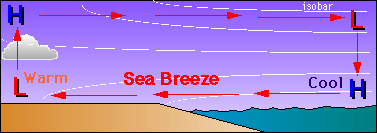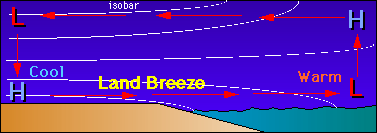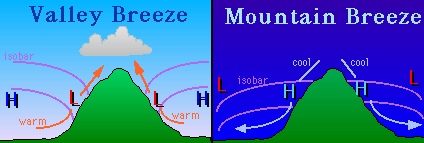Thermal Breezes:
Sea-Land and Mountain-Valley Breezes
The sea and land breeze circulations are good examples of thermal circulations. The sea-breeze forms during the day, the land breeze at night. Here's why:
Sea Breeze
The sea breeze forms due to the differential heating of the air over a region where a large body of water and land meet. Let's look at a situation that might occur at the beach. As you know, land surfaces generally absorb and emit radiation more efficiently than water surfaces. Therefore, the air above the land will heat and expand more rapidly than the air over the water. As we mentioned in the previous section, a relative high pressure area will form aloft over the land, and a relative low pressure area will form over the water. The pressure gradient will force air movement toward the low pressure area, and a thermally driven circulation will form.

The breeze that forms along the surface blowing in from the water (called an onshore breeze) brings in cool air. This is why, during mid-day at the beach, the air is often much cooler than it is just a few miles inland. This air is also very moist, and can form clouds and even storms where it rises over the low pressure area. This separation zone between the warm inland air and the cool sea breeze air is known as a sea breeze front. This front can bring significant precipitation under the right circumstances. For example, in Florida, sea breeze fronts move in from the west and from the east, then converge over central Florida. This convergence pushes more air upward, producing strong thunderstorms. At night, however, the opposite effect takes place, called the land breeze.
Because the land also cools more rapidly than the water, a similar situation occurs late at night, but in the opposite direction. Here, the cooled air over the land contracts, forming a low pressure aloft over land and a relative high pressure aloft over the water. The resulting circualtion is known as a land breeze, because the wind now blows offshore.

The land breeze usually has a smaller magnitude than the sea breeze because the temperature difference at night between land and water is not as large. Still, clouds and storms may develop just offshore due to the rising air over the local low pressure area.
Similar phenomena occur over smaller bodies of water (such as lakes), but on a much smaller magnitude. If a thermal circulation develops over a lake, it is called a lake breeze. These form quite often in the regions surrounding the Great Lakes.
A similar pattern occurs along mountain slopes. The valley air warms rapidly and rises along the mountain slope to form the valley breeze. At night, the surface air quickly cools and slides down the mountain slope, forming the mountain breeze. Although this is due to the terrain of the mountains, it is, technically speaking, thermally driven. These, like the sea and lake breezes, are examples of mesoscale thermal circulations.





Developed by
 The Shodor
Education Foundation, Inc.
The Shodor
Education Foundation, Inc.
Copyright © 1996




 The Shodor
Education Foundation, Inc.
The Shodor
Education Foundation, Inc.